Managing operations across multiple locations presents unique challenges for businesses of all sizes.
Whether you're overseeing a chain of retail stores, restaurant franchises, healthcare facilities, or manufacturing plants, maintaining consistent standards across every site is critical to your brand reputation, compliance requirements, and operational efficiency.
Yet many organizations still rely on paper-based checklists, spreadsheets, and manual processes that create gaps in accountability, make data analysis difficult, and leave room for inconsistency.
Digital checklist platforms have emerged as a transformative solution for multi-site operations, offering centralized control, real-time visibility, and standardized processes that ensure every location meets the same high standards.
.svg)

Priced on per user or per location basis
Available on iOS, Android and Web
The Problem with Traditional Multi-Site Inspections
Before diving into solutions, it's important to understand the challenges that plague traditional inspection methods. Organizations managing multiple locations typically face several recurring problems, which are as follows:

- Inconsistent Execution Across Sites: When each location uses paper checklists or creates its own inspection processes, standards inevitably drift. One site might complete thorough inspections while another rushes through them. Without a standardized approach, you can't ensure that the same criteria are being evaluated the same way at every location.
- Lack of Real-Time Visibility: Paper-based inspections create information silos. Regional managers and corporate teams have no way to monitor inspections as they happen. By the time reports are compiled and sent to headquarters, critical issues may have gone unaddressed for days or weeks. This delay prevents proactive problem-solving and makes it difficult to identify systemic issues across multiple sites.
- Difficult Data Analysis: When inspection data exists on paper forms scattered across dozens or hundreds of locations, aggregating that information for analysis becomes a monumental task. Identifying trends, comparing site performance, and measuring improvement over time requires manual data entry and compilation—a process that's time-consuming, error-prone, and often abandoned altogether.
- No Accountability or Follow-Through: Paper checklists provide no automated way to assign corrective actions or track their completion. Issues identified during inspections often fall through the cracks because there's no system to ensure accountability. Without clear ownership and deadlines, problems persist and compound over time.
- Training and Onboarding Challenges: New managers and employees at different locations may receive inconsistent training on inspection procedures. Without standardized processes and clear guidance built into the inspection tool itself, quality depends heavily on individual knowledge and interpretation.
These challenges create a cascade of problems, such as compliance risks increasing, customer experiences becoming inconsistent, operational costs rising due to inefficiencies, and leadership lacking the data needed to make informed decisions about their multi-site operations.
Core Benefits of Digital Checklist Platforms
Digital checklist apps address these challenges head-on by centralizing inspection processes, automating workflows, and providing real-time visibility across all locations. The benefits extend far beyond simple digitization:
- Enforced Standardization: Digital platforms ensure that every location follows the same inspection process, evaluates the same criteria, and documents findings in a consistent format. This standardization eliminates the variability that plagues paper-based systems and ensures that your brand standards are maintained everywhere.
- Real-Time Visibility and Control: Management teams can monitor inspections as they happen, see which sites have completed their required checks, and identify issues immediately. This real-time oversight enables proactive intervention when problems arise and provides confidence that standards are being maintained across the entire organization.
- Data-Driven Decision Making: When all inspection data flows into a centralized platform, it becomes immediately available for analysis. Leaders can identify trends across locations, benchmark site performance, track improvement over time, and make strategic decisions based on objective data rather than anecdotal reports.
- Built-In Accountability: Digital platforms automatically route corrective actions to the appropriate team members, set deadlines, send reminders, and track completion. This automation ensures that identified issues are addressed promptly and nothing falls through the cracks.
- Improved Efficiency: Mobile apps allow inspectors to complete checklists quickly on smartphones or tablets, with features like photo capture, barcode scanning, and voice notes. Offline capability means inspections can proceed even in areas without connectivity, with data syncing automatically when connectivity is restored.
Key Features That Drive Consistency
Not all digital checklist platforms are created equal. The most effective solutions include specific features designed to maximize consistency across multi-site operations. Here are the capabilities that make the biggest difference:
Template Agent
A robust template management system serves as the foundation for consistency.
Rather than each location creating its own inspection forms, organizations can build master templates at the corporate level and deploy them across all sites. These templates can include:
- Standardized questions and evaluation criteria
- Detailed instructions and reference materials for inspectors
- Photo requirements for specific items
- Scoring methodologies that remain consistent across all locations
- Regulatory references and compliance requirements
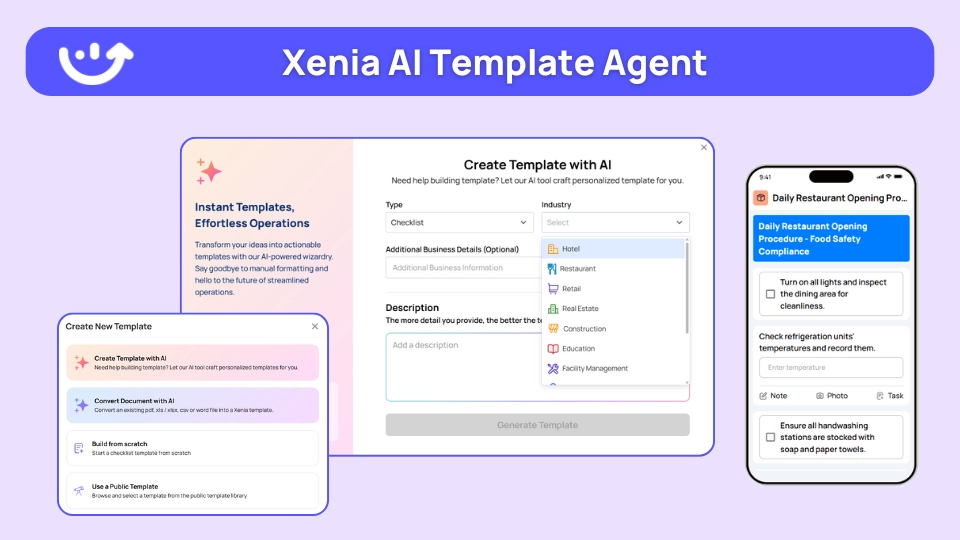
The template agent allows you to maintain a library of inspection types from daily operational checklists to quarterly compliance audits and ensures that every location uses the current, approved version.
When you update a template, those changes propagate to all relevant sites automatically, eliminating version control issues and ensuring continuous improvement.
Weighted Scoring
Not all inspection items carry equal importance. Weighted scoring allows organizations to assign different point values to different criteria based on their impact on safety, compliance, customer experience, or operational efficiency.
This feature ensures that:
- Critical items (like food safety temperatures or emergency exit accessibility) carry more weight than minor aesthetic issues
- Overall scores accurately reflect the most important aspects of operations
- Sites can be ranked and compared fairly based on what matters most
- Resources can be directed to locations with the greatest need for improvement
Weighted scoring transforms subjective inspections into objective, quantifiable assessments that provide meaningful insights into multi-site performance. Here's Xenia's digital checklists with weighted scoring:
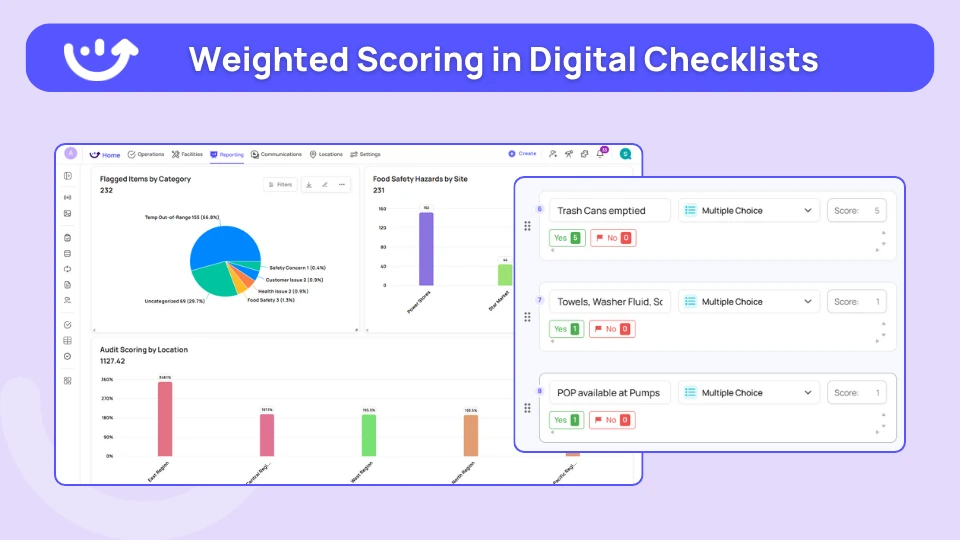
Comparison & Trend Analysis
The ability to compare performance across sites and track trends over time is essential for maintaining consistency. Advanced digital platforms provide dashboards and reports that show:
- How each location scores compared to others in the same region or district
- Which sites consistently perform well, and which struggle with specific aspects
- Whether individual locations are improving or declining over time
- Correlation between inspection scores and business outcomes
- Identification of best practices at high-performing locations that can be shared across the organization
This comparative analysis creates healthy competition between sites, helps regional managers identify where to focus their attention, and provides objective metrics for performance reviews and operational planning.
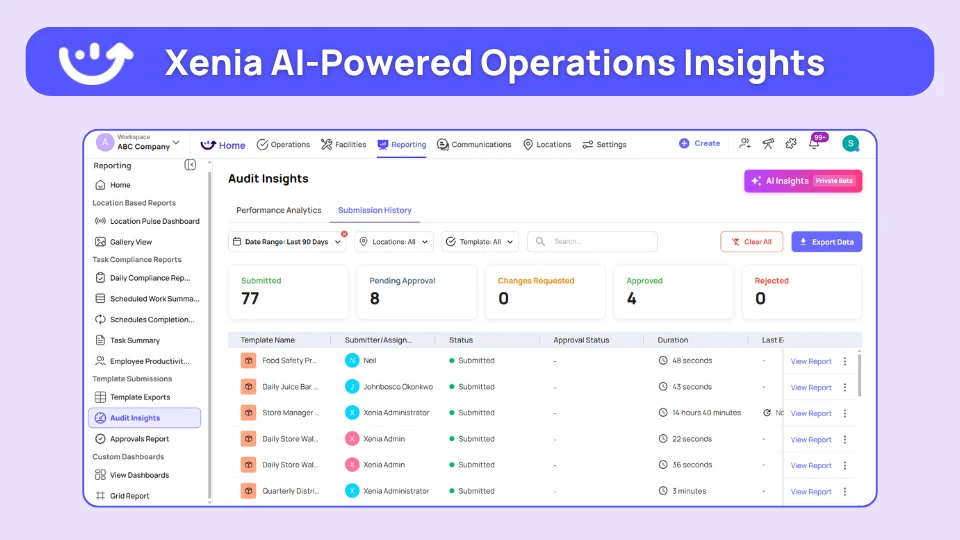
Conditional Logic & Location-Specific Checklists
While consistency requires standardization, it must also accommodate legitimate differences between locations. Conditional logic allows checklists to adapt based on responses, location attributes, or other factors:
- Questions can appear or hide based on previous answers
- Different locations can receive customized versions of a master template based on their size, format, or local regulations
- Seasonal items can automatically include or exclude themselves based on the time of year
- Equipment-specific checks can appear only at locations that have that equipment
This intelligent customization maintains consistency in methodology while respecting necessary differences between locations. A small-format store doesn't need to complete checks for departments it doesn't have, but the inspection process itself remains standardized.

Mobile App with Offline Capability
Field teams need to complete inspections where and when they work—often in environments with poor or no internet connectivity. A robust mobile app with offline capability ensures that:
- Inspections can be completed in warehouses, basements, remote locations, or areas with dead zones
- Data is stored locally on the device until connectivity is restored
- Photos, signatures, and responses are captured without interruption
- Automatic synchronization occurs seamlessly when the device reconnects
This offline functionality removes barriers to adoption and ensures that inspections happen on schedule regardless of connectivity challenges.
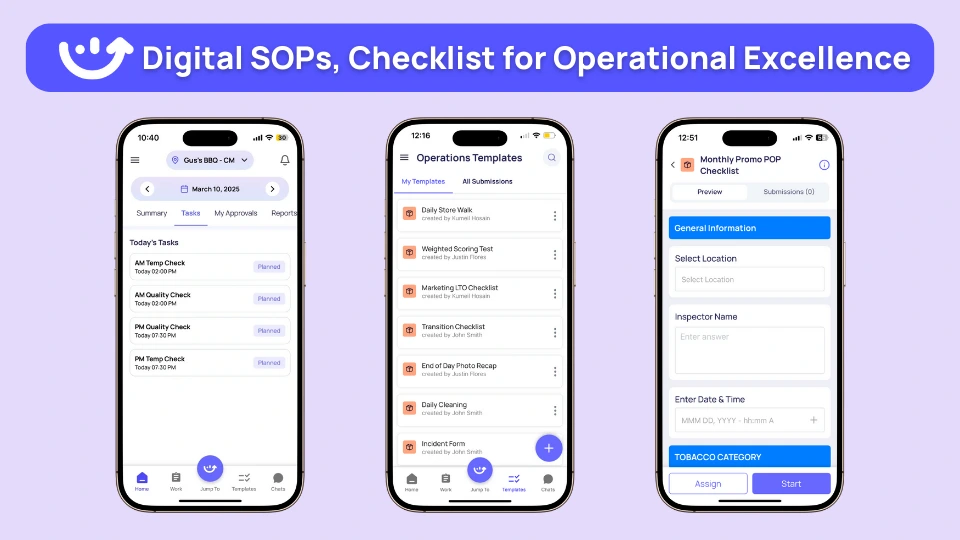
Automated Scheduling & Deployment
Consistency requires that inspections happen regularly and predictably. Automated scheduling features ensure that:
- Daily, weekly, monthly, and quarterly inspections are assigned automatically
- The right people at each location receive their inspection assignments on time
- Reminders are sent before deadlines to ensure completion
- Overdue inspections are flagged for management attention
- Seasonal or event-driven inspections are scheduled appropriately
This automation removes the manual work of inspection coordination and ensures that no location falls behind on required checks.
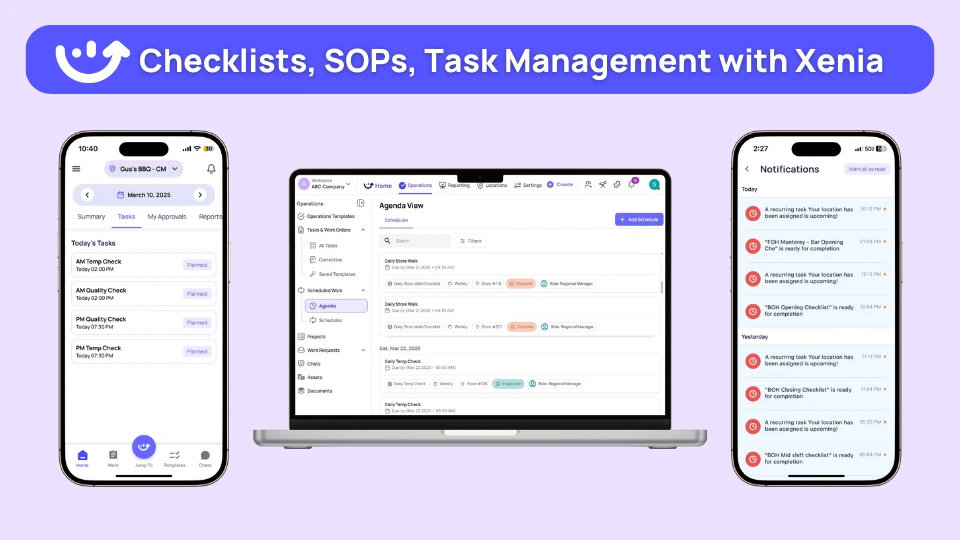
Corrective Action Workflows
Identifying issues during inspections is only valuable if those issues are resolved. Automated corrective action workflows ensure accountability by:
- Automatically creating tasks for identified issues
- Assigning responsibility to specific team members or roles
- Setting deadlines based on issue severity
- Sending reminders and escalations for overdue items
- Requiring photo evidence of completion
- Tracking time-to-resolution metrics
- Closing the loop by verifying that corrective actions were effective
These workflows transform inspections from documentation exercises into action-oriented processes that drive continuous improvement.
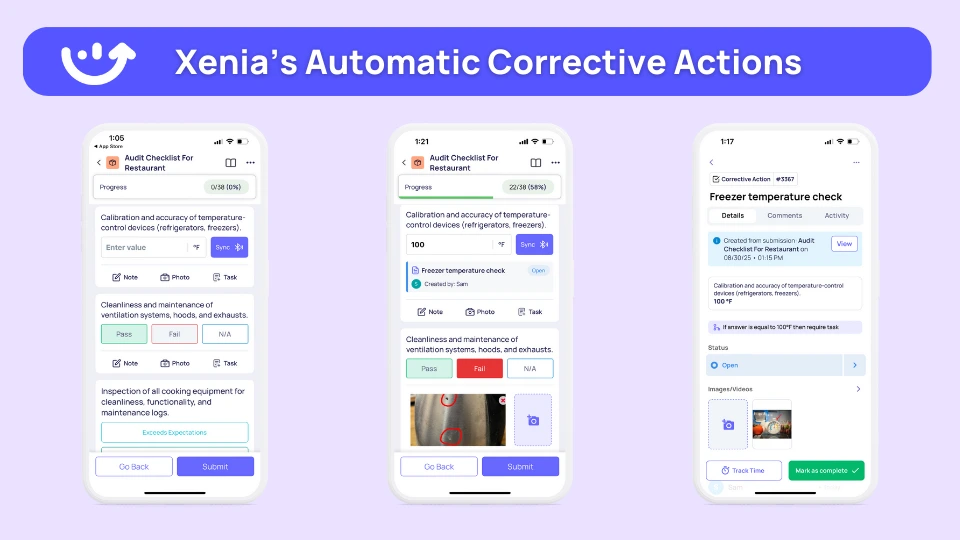
How Digital Platforms like Xenia Ensure Consistency?
- Standardized Processes: Digital checklists ensure every Multi-Site Inspection follows the same steps, criteria, and documentation. They create uniform scoring and consistent corporate standards across all locations. Reference photos and embedded best practices help inspectors apply the same standards regardless of experience.
- Real-Time Oversight: Managers gain instant visibility into completed, pending, or overdue inspections across all sites. Issues can be identified and acted on immediately, preventing systemic problems. Dashboards like Xenia’s show status, photo evidence, and corrective actions in real time.
- Training and Onboarding: Digital platforms guide new employees through inspection procedures with clear instructions and embedded training materials. Videos, guides, and examples support learning in context during inspections. Data also reveals inconsistencies, helping identify who needs additional training.
Conclusion
In today's competitive business environment, consistency across Multi-Site Inspection isn't just a necessity.
It's essential for protecting your brand, meeting regulatory requirements, and delivering the customer experience you've promised.
Traditional paper-based inspection methods simply can't provide the standardization, visibility, and accountability that multi-site operations demand. Digital checklist platforms fundamentally transform how organizations approach inspections and quality control.
Xenia stands out as a comprehensive solution specifically designed for the challenges of multi-site inspections.
The platform combines all the essential features discussed in this article, from flexible template management to powerful analytics, in an intuitive interface that teams actually want to use.
Whether you're managing a handful of locations or hundreds of sites across multiple countries, Xenia provides the tools you need to maintain consistent standards, respond quickly to issues, and continuously improve your operations.

.svg)
.webp)
%201%20(1).webp)






.svg)
%201%20(2).webp)








